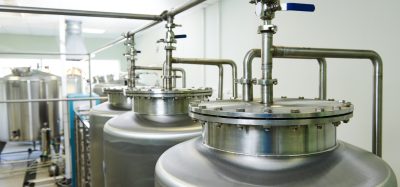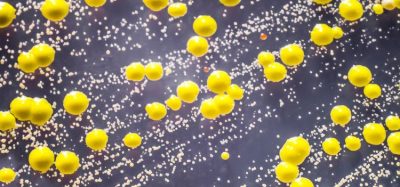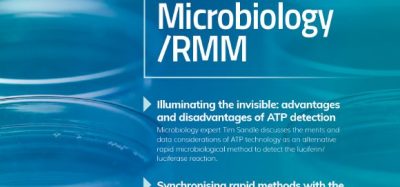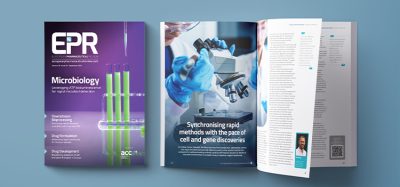The role of water activity in the microbial stability of non-sterile pharmaceutical drug products
Posted: 10 March 2015 | Tony Cundell | No comments yet
Aqueous, multiple-use, non-sterile drug products are susceptible to microbial contamination during their shelf life. To protect these products from this potential hazard to patients, they are formulated with antimicrobial preservatives. Other product attributes employed using the hurdle concept to prevent microbial contamination include: low pH, low redox potential, reduced storage temperature, packaging that protects the product and low water activity.


Water activity, or Aw, is a measure of available water and when applied to a non-sterile pharmaceutical drug products is a critical physical attribute that determines whether the product will support the growth of microorganisms. Given the knowledge of the minimum water activity for the growth of bacteria, yeast and mold, the microbial stability of a drug product can be determined. This knowledge can be used to set risk-based microbial specification and release and stability testing programs for different dosage forms. This review article will discuss the role of reduced water activity in imparting microbial stability to non-sterile drug products.
Water activity ranges from 1.00 for pure water to 0.00 for a bone-dry material. The pioneering Australian microbiologist Scott concluded that as the water activity is reduced below the optimum for the growth of a particular microorganism, there is an increase in lag phase, a decrease in growth rate, and a decrease of the total numbers of the microorganism produced at the stationary phase until water activity is reached where no growth occurs. This pattern is similar to the effect of reducing the temperature. As microorganisms that would be found in pharmaceutical products require a water activity of at least 0.75 for microbial growth, the proliferation of microorganisms within a drug product can be controlled by the inherent low water activity and/or reducing the water activity of the drug product. For example, oral liquids with a water activity of greater than 0.95, if unpreserved, would support microbial growth, especially bacteria, while a topical ointment with a water activity of 0.58 would not support any microbial growth. Since microorganisms need water within a pharmaceutical product to proliferate, water activity and not water content is a better measure of the free water, in contrast to bound water that microbial cells require for metabolic activity and osmotic regulation.
The most common pharmaceutical dosage form (>80%), compressed tablets, typically have water activities in the range of 0.3-0.4, hence, if stored in packaging that excludes moisture, such as high density polyethylene bottles with heat induction seals and screw-top lids, will not support microbiological growth during the drug product shelf life.
Measuring water activity
USP Informational chapter <1112> Application of water activity determination to non-sterile pharmaceutical products references the dew point/chilled mirror method contained in the Official Methods of Analysis of AOAC International as a suitable method for water activity determination. Other methods that can be used include electronic humidity sensors, hair hygrometers and laser headspace moisture instrumentation (Table 1). The water activity information as stated in USP <1112> may be used to: develop product formulations, set microbiological release specifications, establish microbial testing programs and determine potential shelf life stability from microbial growth. Water activity determination should be a routine part of formulation development and may be used as tool for microbiological risk assessment and microbial specification setting. For a comprehensive discussion of the application of water activity in the pharmaceutical industry, the reader is referred to the book the author co-edited with Anthony Fontana3.
Mathematically, water activity is the ratio of the vapour pressure of water in a product (P) to the vapour pressure of pure water (Po) at the same temperature. It is numerically equal to 1/100 of the relative humidity (RH) generated by the product in a closed system and it is a measure of the free or available moisture in the material. It is important to note that water activity does not equate to water content of the product that may be established for a drug product by constructing a water sorption isotherm. The RH of a drug product can be calculated either from direct measurements of partial vapour pressure or dew point, from indirect measurement by sensors, whose physical or electric characteristics are altered by the RH to which they are exposed, or by laser headspace analysis.
The relationship between water activity and the equilibrium relative humidity (ERH) at a specified temperature is represented by the following equations:
Aw = P/Po
ERH (%) = Aw x 100.
In the dew point/chilled mirror method of taking a water activity measurement, a polished, chilled mirror is used as a condensing surface. The cooling system is linked electronically to a photoelectric cell into which light is reflected from the condensing mirror. Air is directed to the mirror (in equilibrium with the test sample), which cools until condensation, detected by the photoelectric cell, occurs on the mirror from which the ERH is determined. The instrument is calibrated using saturated salt solutions at 25°C, for example, a saturated sodium chloride solution has an ERH of 75.3% and an Aw of 0.753.
Water activity for microbial stability
Water activity determination during new product formulation and manufacturing process development is useful tool in microbial risk assessment. The general parameters employed in a risk assessment are the microbiological quality of the drug product and excipients, the formulation, manufacturing process, product attributes and intended recipients of the drug product. Water activity would be a critical product attribute affecting microbial stability. The risk assessment, as well as a supporting drug product microbial testing history during development, can be used to justify the elimination of a microbial specification for a new drug product.
However, many non-sterile pharmaceutical products manufactured in compliance with current Good Manufacturing Practices have a little or no potential for microbial contamination so microbial testing is not a value-added activity. Microbial testing can increase the product release cycle time adding to inventory costs and back orders. When justified by formulation, manufacturing processes, patient profiles, and testing histories, lot-by-lot Microbial Limit testing of liquid- and powder-filled capsules, compressed tablets, rectal suppositories, topical ointments, inhalation aerosols and lip balms may be replaced by periodic, annual or even no testing. As water activity is a test parameter that reflects the drug product formulation and manufacturing process, it may be considered a conservative property of a drug product that would not significantly change during the shelf life of a product unless the product was hydroscopic and was subjected to uncontrolled exposure to a high relative humidity environment. Testing of one to three stability study batches of drug product and the confirmation that the water activity does not significantly change when stored in the product packaging over the shelf life should be sufficient to establish the water activity range as part of the microbial risk assessment.
The microbial resistance of other dosage forms may be increased by decreasing the water activity of the formulations, extremes of pH and by adding antimicrobial preservative systems. For example, multiple-use aqueous drug products with water activities greater than 0.75 would be formulated with a preservative system and be subjected to routine microbial limit testing for release. Drug products with water activities below 0.75 could be considered non-aqueous so would not be preserved, and after a risk assessment would not subjected to routine microbial limit testing for release. The U.S. Food and Drug Administration’s Draft Guidance for Industry – Drug Product Chemistry, Manufacturing, and Controls (CMC) Information, January 2003, references Decision Trees # 6 and #8 in ICH Q6a Specification for the rationale for not performing microbial limits testing for non-sterile drug substances and excipients, and non-sterile drug products. Table 2 shows the water activity requirements for growth of representative microorganisms.
A review of the water activities of a range of pharmaceutical dosage forms reveals that they fall into those with a high potential risk for microbial contamination, for example, aqueous products and those with a low potential risk for microbial contamination (Table 3). The growth of bacteria is supported by high water activity (>0.90) at which bacteria outcompete yeast and mould while at lower Aw (0.85 to 0.75), fungal but not bacterial growth will occur.
As discussed by Skowronsky5, during the development of new drug substances and drug products, product testing of physical, chemical and microbiological attributes are performed to ensure the product will meet specified criteria of quality, safety and strength. Further testing is performed as part of the stability program to ensure these materials continue to meet the criteria for quality, safety and strength, in the proposed packaging configurations, through their expiration or shelf-life at the storage temperatures and humidity required by specific markets.
Standardised regulations
The International Conference of Harmonization (ICH), through a cooperated effort with Europe, Japan, and USA, has agreed on standardised regulatory requirements concerning the registration process for the pharmaceutical industry to include ICH Q6A Specifications: Test Procedures and Criteria of New Drug Substances, and Products; and ICH Q1A Stability Testing of New Drug Substances and Products.
Topics of interest include:
- Requirements for microbiological testing on stability for different dosage forms
- Selection of appropriate microbial attribute tests, conditions, and frequency
- Relationship of moisture and water activity on microbial stability
- Replacement of microbial testing with water activity
- A proposed stability protocol outlining microbial and water activity testing
Microbiological testing within a R&D or marketed product stability program include microbial enumeration (total aerobic microbial counts and total combined yeast and mould counts) and antimicrobial effectiveness testing. Tests for the absence of specified microorganisms are limited to release and not stability testing. Other tests to support microbial stability would include preservative assay, water activity and container-closure integrity. The stability and temperature requirements are defined in Table 4.
The frequency of testing for a 12-month storage period is every three months in long-term storage conditions for the first year; every six months during the second year; and annually thereafter. Testing every three months is suggested at accelerated conditions. At intermediate storage conditions, if required, at least four time points (zero, six, nine, 12 months) is recommended. Reduced testing by matrix design may be appropriate where justified (see guidance in ICH-Q1D).
Points to note in microbiological testing in stability programs are that, firstly, unlike physicochemical changes, accelerated conditions (i.e. 40°C, 75% relative humidity) are not the worst-case conditions for non-sterile drug products stored at ambient temperature. Many fungi will not growth at 40°C and this temperature is beyond the optimal temperature for most bacteria. Secondly, for low water activity products protected from elevated humidity by low moisture transmission packaging configurations, water activity measurement is a better indicator of microbial stability than microbiological examination testing. The third point is that demonstrated antimicrobial preservative efficacy at 50, 75 and 100% of the preservative concentration will enable companies to set a lower shelf life specification for the preservative level. After conducting Antimicrobial Effectiveness Testing on at least one full-scale batch in the marketed packaging configuration through expiry, it is recommendable to default to preservative assay only in the marketed product stability program.
An example of microbiological testing in product stability programs, during either R&D or marketing stages, can be found in Table 5 (solid oral dosage forms and other low water activity products) and Tables 6 and 7 (topical lotions, creams, and gels).
Conclusion
Water activity is a useful measure of microbial stability that can be successfully used in product development and microbial risk assessments to support specification setting and testing decisions for both product release and stability studies.
References
- Leistner, L. (1978) Hurdle effect and energy savings In Food Quality and Nutrition W. K. Downey (editor) Applied Sciences Publisher, London pp 553-557
- Scott, W. J. (1957) Water relations of food spoilage microorganisms. Adv. Food Rev. 7: 83-127Cundell, A. M. and A. J. Fontana Jr. (2009) Water Activity Applications in the Pharmaceutical Industry. A. M. Cundell and A. J. Fontana, Jr (editors) pp 291 PDA/DHI
- Cundell, A. M. (2009) Effects of water activity on microorganisms. In Water Activity Applications in the Pharmaceutical Industry A. M. Cundell and A. J. Fontana, Jr (editors) pp 175-204 PDA/DHI
- Skowronsky, L. (2009) Use of water activity to support microbiological stability In Water Activity Applications in the Pharmaceutical Industry. A. M. Cundell and A. J. Fontana, Jr (editors) pp223-247 PDA/DHI
Biography
Dr. Tony Cundell works as a consulting microbiologist supporting the pharmaceutical industry. Prior to November 2013 he worked for Merck Research Laboratories in Summit, New Jersey, as the Senior Principal Scientist in early phase drug development. Earlier in his career, Tony Cundell worked at a director level in Quality Control and Product Development organisations at the New York Blood Center, Lederle Laboratories, Wyeth Pharmaceuticals and Schering-Plough. He is a member of the 2010-2015 U.S. P Microbiology Committee of Experts. In June, 2009, he co-edited with Anthony Fontana a book entitled Water Activity Applications in the Pharmaceutical Industry and contributed two chapters to the book. Tony Cundell has a PhD in Microbiology from the Lincoln University, New Zealand.









